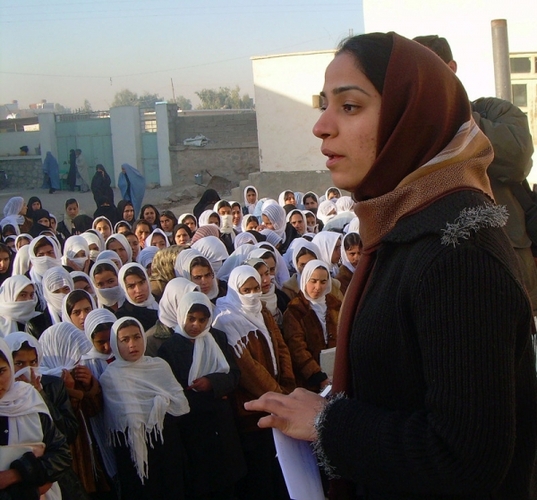SAXTONS RIVER — Back in the 1920s, things looked hopeful for women in Afghanistan.
King Amanullah Khan and his wife, Queen Soraya, worked diligently to improve women's lives. The king discouraged polygamy, advocated against the veil, and pushed for greater personal freedom for females. “Tribal custom must not impose itself on the free will of the individual,” he said.
His sister, Kobra, created the Organization for Women's Protection, while another sister established a women's hospital. Queen Soroya even founded the first magazine for women.
By the end of this progressive decade, conservative tribal leaders pushed back against the growing freedoms for women, and the king's successor acquiesced.
Still, urban women entered the workforce in the 1930s, mainly as teachers and nurses, and by 1959 many had unveiled. A 1964 constitution gave women the right to vote and to enter politics.
All of these advances, and those that followed in the 1970s and '80s, came to a crashing halt when the Taliban came to power in 1996 following Soviet rule. We're familiar with their brutal oppression of women, symbolized by blue burkas and stoning deaths.
* * *
Post-Taliban, things seemed to improve. A woman was elected to the Loya Jirga - the grand assembly model that governs disputes in Afghanistan - in 2003, and within the following year, a new constitution codified that “the citizens of Afghanistan - whether man or woman - have equal rights and duties before the law.”
In 2008, the first political party dedicated to women's rights was launched and, of the more than five million children enrolled in schools, 35 percent were girls.
That was also the year that acid attacks on female students began.
* * *
The facts about Afghan women are chilling.
Only 14 percent are literate. Their maternal mortality rate is the second highest in the world. Almost 80 percent of rural women have no access to health care. Nearly 60 percent of marriages involve girls younger than 16, and more than 87 percent of Afghan women are in forced marriage or suffer physical or sexual abuse by their husbands. Average life expectancy for women is 44 years.
“The fall of the Taliban brought global attention to the plight of Afghan women,” a 2010 Afghanistan Online piece notes. “But even with a sizable amount of aid and scores of consultants and projects, palpable changes remain elusive.”
That year, prominent Afghan women gathered in Kabul to spearhead a campaign to improve the lives of Afghan women through legislation while changing the prevailing male mindset. For despite the 2004 Constitution, old laws and tribal customs continued in the face of a government unwilling to enforce the law.
Today, in spite of the efforts of many Afghan women who repatriated to help the women of their country, the situation remains bleak.
Last spring, a member of the Revolutionary Association of Women in Afghanistan (RAWA) told an interviewer that the country remains extremely dangerous for women. She said that 90 percent of Afghan females have experienced some form of violence and that the suicide rate among women is climbing because women feel hopeless.
When security was handed over from NATO to Afghan forces and U.S. troops began preparing for withdrawal, women's concerns loomed large in the face of escalating attacks on high-profile women. Legislative and policy changes aimed at improving women's lives are also being targeted. The 2009 Elimination of Violence Against Women law might be amended to exempt relatives of the accused, prohibiting them from being questioned about abuses they've witnessed.
Some politicians have called for eliminating the minimum marriage age, while others want to abolish women's shelters and remove criminal penalties for rape. The quota for women in government has been lowered; some want it ended altogether.
Meanwhile, the Taliban is regaining legitimacy as an acceptable partner in peace-building.
Malalai Joya, a young activist elected to the Afghan parliament in 2005 (later removed from her post), told The Nation last November, “In rural areas, the situation for women is like hell.”
Noting the “mafia parliament,” Joya said that the majority of seats “belong to warlords, drug lords, even Taliban.”
Of the 28 percent of parliament who are women, most are “pro-warlord, pro-occupation, and have a symbolic role.”
“We've seen rape cases, acid attacks, burning girls' schools, cutting the nose and ears off women, beating women with lashes in public, executing them in public, accusing them of adultery without even bringing them to the symbolic courts that we have,” Joya said.
Such testimony calls into question a multi-million dollar program announced a year ago to support Afghan women's political participation. It calls for collaboration between the Independent Election Commission of Afghanistan and the Asia Foundation, and is aimed at voter turnout among women during the next elections.
As one RAWA spokeswoman put it when asked if an Afghan Spring might be possible in Afghanistan, “Things are not moving to the right direction.”
Change takes time, she said, and there won't be a quick solution.
“As a mother, I dream a safe, secure life for my children. Every mother here has this dream.”
